Importance of number 1 in Hinduism (significance) (facts) | What is the significance of the number 1? | What is special about the number 1? | Why is the number 1 powerful? | What is the symbolism of 1? | What does the number 1 mean spiritually
Namaste friends, how are you doing today? Welcome to #BhagavanBhakthi website / blog.
Bhagavan Lord Sri Krishna (Vishnu) (Rama) (Trivikrama) (Narasimha) and Goddess Rukmini (Lakshmi) (Kamala) (Jaya) blessings to you and your family!
In this website / blog, you will always learn about #Hinduism #Sanskrit language.
Also subscribe to my YouTube channel from this link #BhagavanBhakthi to view videos about #Hinduism #Sanskrit language.
Just before going to “Importance of number 1 in Hinduism (significance) (facts) | What is the significance of the number 1? | What is special about the number 1? | Why is the number 1 powerful? | What is the symbolism of 1? | What does the number 1 mean spiritually“, let us know a brief, basic and very important information.
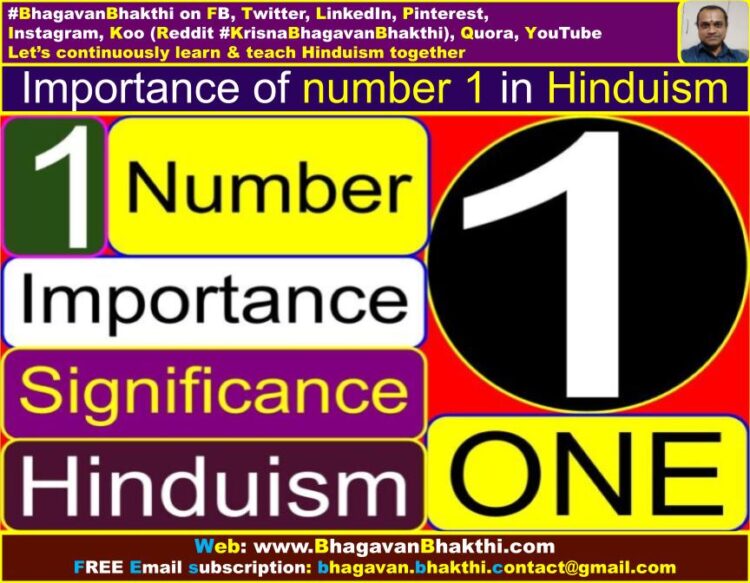
Hindu Sanatana Dharma is definitely the most unique and highly open minded Dharma among all the Dharmas on the planet. We as Hindus, give importance starting from ‘anu’ / atom to ‘Meru Parvata’ / Meru Mountain and it goes on and doesn’t stops anywhere.
For Hindus, every akshara / alphabet, every number, every word, every sentence, every paragraph, every chapter, every book, every grantha (scripture), every shastra (Hindu Texts) etc. etc. etc. has it’s own importance and significance.
For Hindus, the number starting from ‘shoonya’ (zero) and up to the infinite (ananta) number is having great relevance. Since ‘adi samayam’ / unknown time we were aware of the ‘sankhya shastra’ / numerology.
Whether it is minus infinity (अनन्तं न्यूनीकृत्य) or plus infinity (अधिक न्यूनीकृत्य), we Hindus were knowing everything and anything since unknown timeframe. Be it science, technology, space science, communication, about metals, architecture, etc. etc. etc. all were known to Hindus.
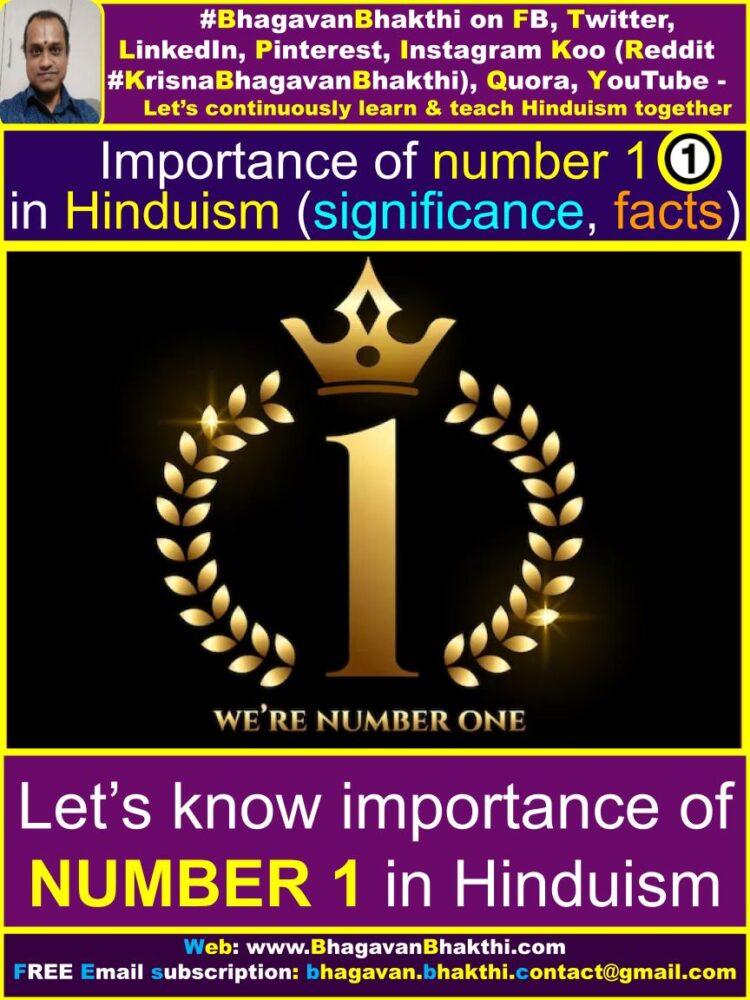
Come on friends, today we will learn few of the importance facts about the number 1 / one as per Hindu Sanatana Dharma as given below:
Eka patni vratastha (एक पत्नी व्रतस्थ) : The meaning of this word is: eka patni vratastha – eka + patni + vratastha (vrata + astha). Here eka = one, patni = wife, vrata = taking vow, astha = I am doing.
This means, a male person taking a vow to have only one wife in his whole life time and also this person will take vow that he will never ever have any affair with any other woman in his whole life. Greatest example for this is Lord Sri Vishnu and Goddess Sri Sita Devi.
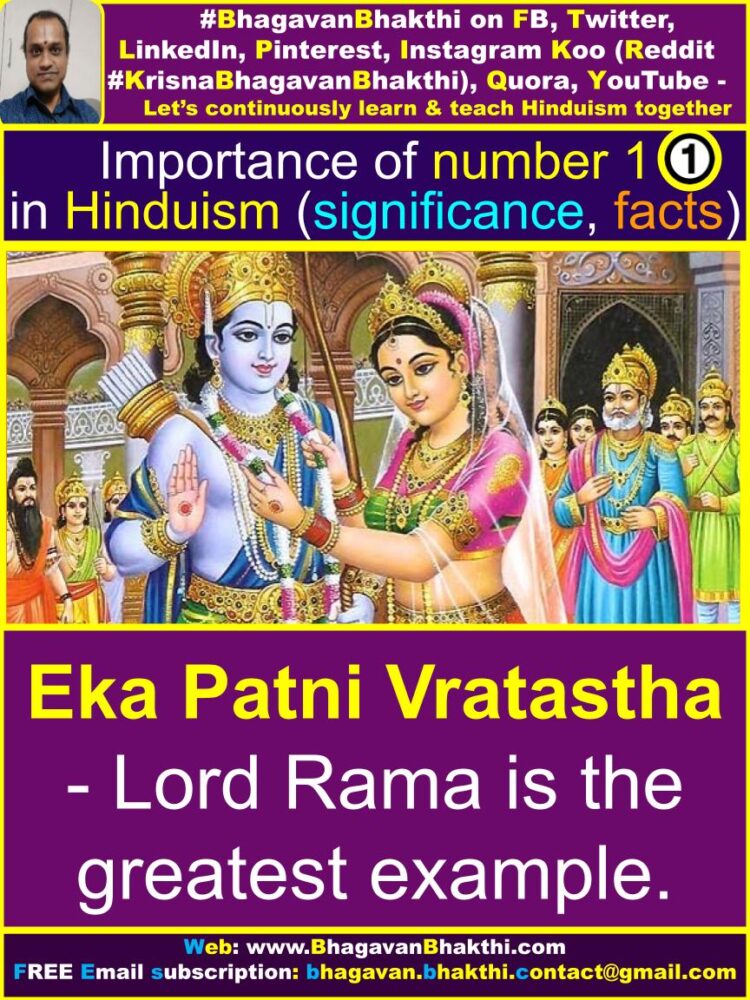
Eko VishnuH (एको विष्णुहुः महद्भूतः) : Many people think that, in Hinduism there are multiple Gods (politheism) / Bhagavans. But does Sanatana Dharma also say so? No… In Hinduism, our shastras / scripts very clearly mentions every time that, we have only one Bhagavan (God).
‘Eko Vishnu Mahadbhutah’ – This means there is only one gigantic presence in the unlimited multiverses who can be called as Bhagavan / God. And that is none other than Lord Sri Vishnu himself. Lord Sri Vishnu is there everywhere and inside everyone. He is present as ‘antaryami’ in everyone and everything.
We can easily find a reference for this quote in the ‘phala shruti’ of ‘Sri Vishnu Sahasranama Stotram’ shloka #20 as given below –
एको विष्णुर्महद्भूतं पृथग्भूतान्यनेकशः | त्रिन लोकान व्याप्य भूतात्मा भुंक्ते विश्वभुगव्ययः ||
ಏಕೋ ವಿಷ್ಣುರ್ಮಹದ್ಭೂತಂ ಪೃಥಗ್ಭೂತಾನ್ಯನೇಕಶಃ । ತ್ರೀನ್ ಲೋಕಾನ್ ವ್ಯಾಪ್ಯ ಭೂತಾತ್ಮ ಭುಂಕ್ತೇ ವಿಶ್ವಭುಗವ್ಯಯಃ ।।
ēkō viṣṇurmahadbhūtaṁ pr̥thagbhūtān’yanēkaśaḥ। trīn lōkān vyāpya bhūtātma bhuṅktē viśvabhugavyayaḥ।।
Someone who can’t be and has unparalleled in excellence, he is Lord Sri Vishnu. Lord Sri Vishnu is the primordial Supreme Bhagavan (God), the ultimate personality.
Lord Sri Vishnu pervades the many, various and different objects of three Universes (here three Universes means, multiverses) and the three worlds (here also three worlds means, multiverses) of souls. Lord Sri Vishnu is the lasting as the inner soul (paramatma) of every being.
Lord Sri Vishnu is the one who protects and enjoys all entities in the multiverses, but still remains unscathed by their faults. He is the one who can’t be destroyed by anyone or anything.
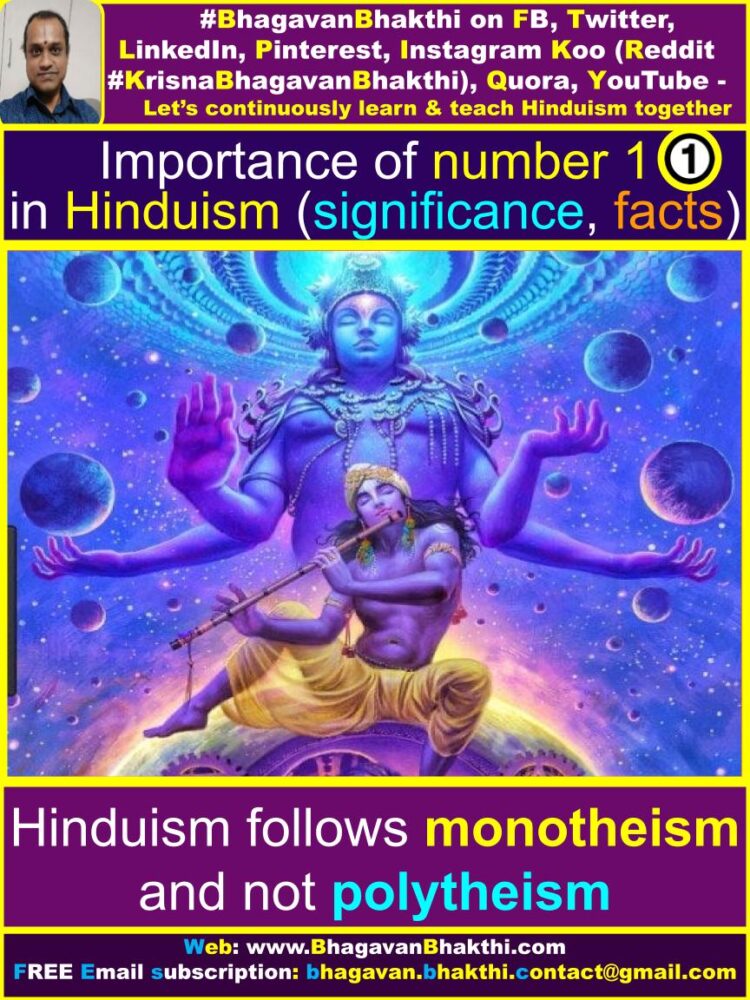
Ekadashi (एकादशी) : Here Ekadashi = Ekaadashi = Ekaa + dashi = one + ten. This means, the 11th day, that is 1+10 day that occurs twice in a ‘Chandramana Panchanga’ / Lunar calendar. Here first or ‘one’ means Lord Sri Vishnu (Ekasmai Namah).
Ekadashi is highly favorable and most favorite day for Lord Sri Vishnu. This day is also called as ‘haridina (haridin)’, this means, Lord Sri Hari’s (Vishnu) day.
न गायत्राय पर मन्त्रं, न मातृ पर दैवं | न काश्य पर तीर्थं, न एकादश्य समं व्रतं ||
ನ ಗಾಯತ್ರಾಯ ಪರ ಮಂತ್ರಂ, ನ ಮಾತೃ ಪರ ದೈವಂ | ನ ಕಾಶ್ಯ ಪರಂ ತೀರ್ಥಂ, ನ ಎಕಾದಶ್ಯ ಸಮಂ ವ್ರತಂ ||
na gāyatrāya para mantraṁ, na mātr̥ para daivaṁ | na kāśya paraṁ tīrthaṁ, na ekādaśya samaṁ vrataṁ ||
The above shloka’s explanation is as given below: There is no better mantra than “gayatri mantra”, there is no greater God than mother, there is no pilgrimage place than Kashi, there is no better vrata (vrat) (vow) than Ekadashi.”
Ekadashi is the ultimate vrata (vrat) (vow) that Lord Sri Vishnu has given to mankind. We need to make full use of it and do the Ekadashi vrata (vrat) (vow) twice in a month.

Ekashloki Ramayanam (एकश्लोकी रामायणम्) : Ekashloki Raamaayanam – Eka + shloki + Raamaayanam. This means, whole of the great “Ramayana” has been told in just one shloka.
आदौ राम तपोवनादि गमनं हत्वा मृगं कांचनं । वैदेही हरणं जटायु मरणं सुग्रीव सम्भाषणं ॥ वाली निर्ग्रहणं समुद्र तरणं लंकापुरी दाहनं । पश्चात रावण कुम्बकर्ण हननं एतद्धि रामायणं ॥ इति एकश्लोकि रामायणं सम्पूर्णम् ॥
ಅದೌ ರಾಮ ತಪೋವನಾದಿ ಗಮನಂ ಹತ್ವಾ ಮೃಗ ಕಾಂಚನಂ | ವೈದೇಹೀ ಹರಣಂ ಜಟಾಯು ಮರಣಂ ಸುಗ್ರೀವ ಸಂಭಾಶಣಂ || ವಾಲೀ ನಿಗ್ರಹಣಂ ಸಮುದ್ರತರಣಂ ಲಂಕಾಪುರೀ ದಹನಂ | ಪಶ್ಚಾತ್ ರಾವಣ ಕುಂಭಕರ್ಣ ಹನನಂ ಏತದ್ಧಿ ರಾಮಾಯಣಮ್ || ಇತಿ ಏಕಶ್ಲೋಕಿ ರಾಮಾಯಣಂ ಸಂಪೂರ್ಣಂ ||
adau rāma tapōvanādi gamanaṁ hatvā mr̥ga kān̄canaṁ | vaidēhī haraṇaṁ jaṭāyu maraṇaṁ sugrīva sambhāśaṇaṁ || vālī nigrahaṇaṁ samudrataraṇaṁ laṅkāpurī dahanaṁ | paścāt rāvaṇa kumbhakarṇa hananaṁ ētad’dhi rāmāyaṇam || iti ēkaślōki rāmāyaṇaṁ sampūrṇaṁ ||
Meaning of this shloka is as given here: Once upon a time, Lord Rama went to forest. He chased the deer. Goddess Sri Sita Devi was kidnapped, Jatayu bird was killed. There were discussions with Sugriva.
Vali was killed. The sea was crossed. Lanka was burnt and later Ravana and Kumbhakarna were also killed. This is the story of Ramayana. Thus the Ramayana is completed.

Ekabhukta (एकभुक्त) : Here Ekabhukta – Eka = once, bhukta = eating food. Thus total meaning of Ekabhukta is, having food only once in a day.
It is one of the vrata (vrat) (vow) / austerities that is usually carried during few specific periods like ‘chaturmasam’, ‘adhika masam’ etc.
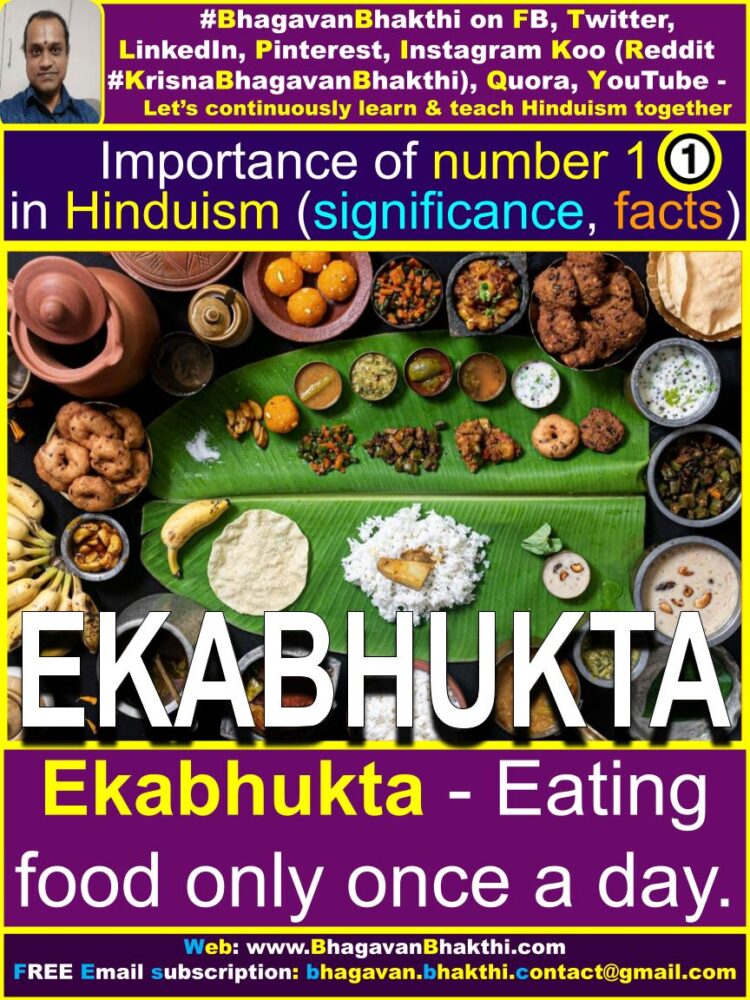
Ekam Shastram (एकं शास्त्रं) – Bhagavad Gita :
एकं शास्त्रं (भगवद गीत) | एकं शास्त्रं देवकि पुत्र गीतं | एको देवो देवकि पुत्र एव | एको मंत्रस तस्य नामानि यानी | करमपि एकं तस्य देवस्य सेवा | (गीत माहात्म्य) ||
ಏಕಂ ಶಾಸ್ತ್ರಂ (ಭಗವದ್ ಗೀತ) | ಏಕಂ ಶಾಸ್ತ್ರಂ ದೇವಕಿ ಪುತ್ರ ಗೀತಂ | ಏಕೋ ದೇವೋ ದೇವಕಿ ಪುತ್ರ ಏವ | ಏಕೋ ಮಂತ್ರಸ್ ತಸ್ಯ ನಮಾಮಿ ಯಾನಿ | ಕರ್ಮಪಿ ಏಕಂ ತಸ್ಯ ದೇವಸ್ಯ ಸೇವಾ | (ಗೀತಾ-ಮಹಾತ್ಮ್ಯ) ||
ēkaṁ śāstraṁ (bhagavad gīta) | ēkaṁ śāstraṁ dēvaki putra gītaṁ | ēkō dēvō dēvaki putra ēva | ēkō mantras tasya namāmi yāni | karmapi ēkaṁ tasya dēvasya sēvā | (gītā-mahātmya) ||
The only one shastra (text) is Bhagavad Gita. The only Shastra is the one which is sung by the son of Devaki. There is only one hymn to be sung, those are the names of the son of Devaki. There is only one duty, that is the service for this Supreme Lord (Sri Krishna).
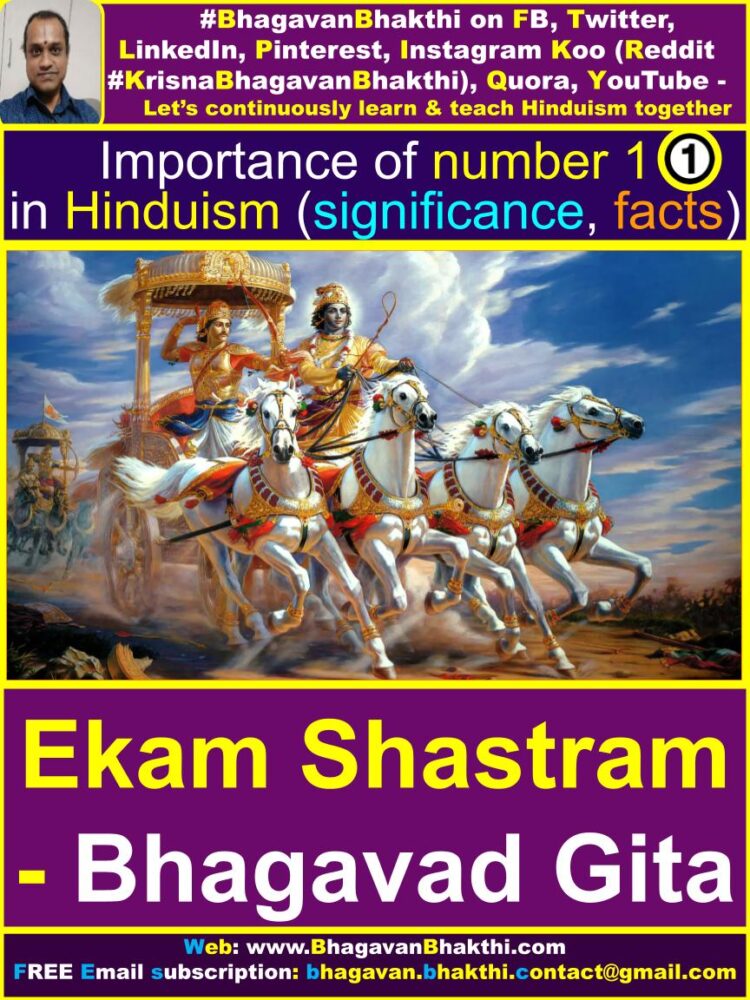
Eko Narayanah (एको नारायणः) : Eko Narayanah = Eko Naaraayanah – Eko = one, Naaraayanah = Only Narayana. This means, there is only one Bhagavan (God), that is, Lord Sri Narayana / Vishnu is the only one Bhagavan / God.
There is no one else who can be called as Bhagavan (God) or who is equal to Lord Sri Narayana (Vishnu) or above him. Narayana Upanishad describe Lord Sri Narayana as below:
एको नारायणः न द्वितीयो स्ति कश्चित् । ಏಕೋ ನಾರಾಯಣೋ ನ ದ್ವಿತಿಯೋ ಕಶ್ಚಿತ್ | eko nārāyaṇaḥ na dvitīyo’sti kaścit ।
There is only one Lord Sri Narayana (Vishnu or any of his avatars), he is the Supreme Bhagavan (God). There is no one who can be as superior than him and also there is no second Bhagavan (God) who is equal to Narayana (Vishnu or any of his avatars).
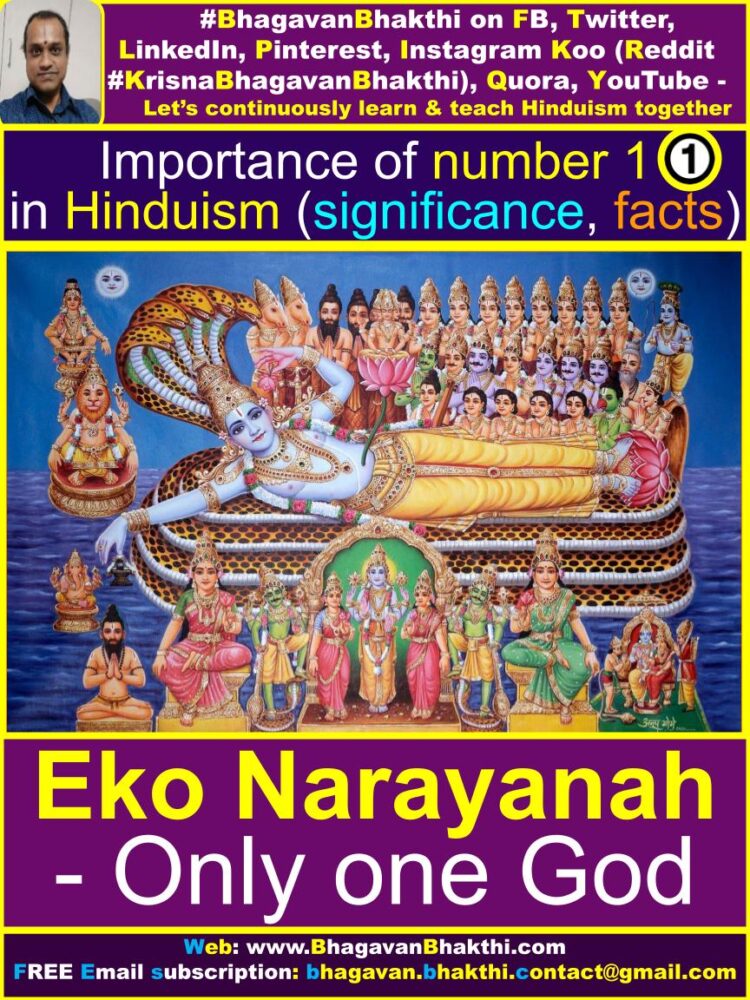
Eka Chakradharam Devam (एक चक्रधरं देवं) : This is taken from सूर्याष्टकं / Suryashtakam.
बंधुक पुष्प संकाशं हरकुण्डल भूषितं | एक चक्रधरं देवं तं सूर्यं प्रणामंयहां ||
ಬಂಧೂಕ ಪುಷ್ಪ ಸಂಕಾಶಂ ಹರಕುಂಡಲ ಭೂಷಿತಂ | ಏಕ ಚಕ್ರಧರಂ ದೇವಂ ತಂ ಸುಯಂ ಪ್ರಣಾಮಂಯಹಂ ||
bandhūka puṣpa saṅkāśaṁ harakuṇḍala bhūṣitaṁ | ēka cakradharaṁ dēvaṁ taṁ suyaṁ praṇāmanyahaṁ ||
In the ‘Suryashtakam’ sung by Samba (son of Lord Sri Krishna and Jambavati Devi), we can find that Lord Sri Surya Deva / Sun Demigod has being described as ‘Ekachakradharam Devam’. Here ‘Ekachakradharam Devam’ means, Lord Sri Surya Deva has one wheel to his chariot.
Here it is explained that, the ratha / chariot of Lord Sri Surya Deva has only one chakra / wheel that represents kalachakra (कालचक्र) (kālacakra).
Entire kalachakra, or ‘wheel of time’, is established on the wheel of Lord Sri Surya Deva’s ratha / chariot. This wheel is known as Samvatsara (one whole cycle of Samvatsara – that is, 60 years).
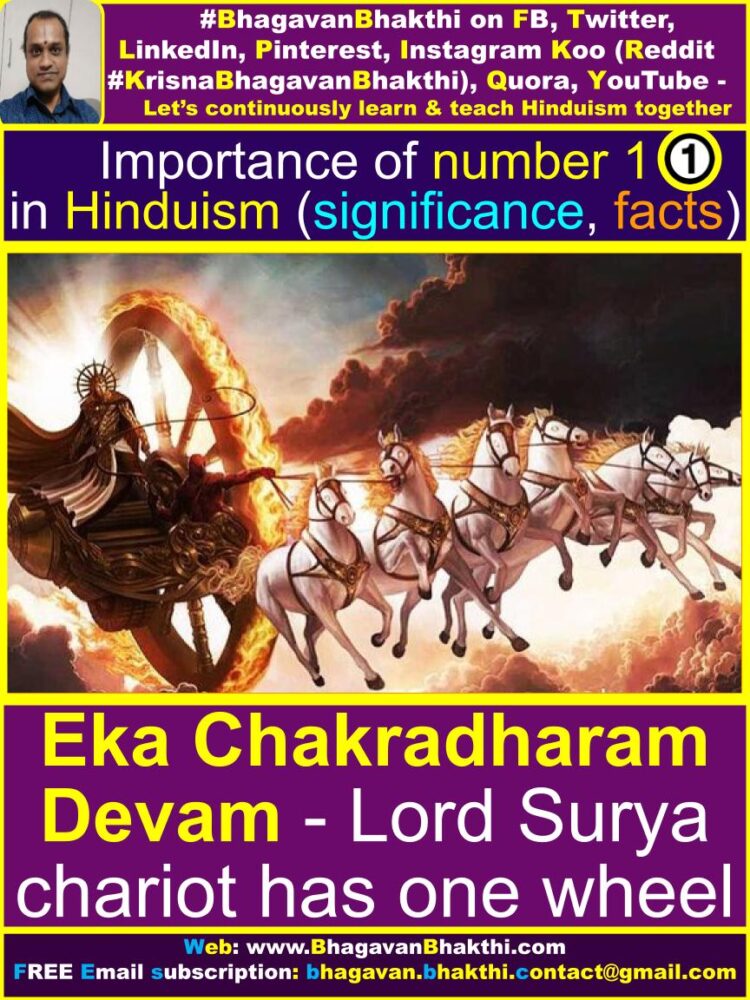
Ekalavya (एकलव्य) : In the great Epic Mahabharatha we can find the Ekalavya character. He was the son of tribal king who aspired to learn archery under the guidance of Dronacharya. But Dronacharya denies Ekalavya’s request, as Ekalavya and his family were the enemies of Kauravas and Yadavas.
Later on Ekalavya build a statue of Dronacharya and started practicing the archery.
You can find the more details of Ekalavya from here : Sri Krishna killed Ekalavy, but why?
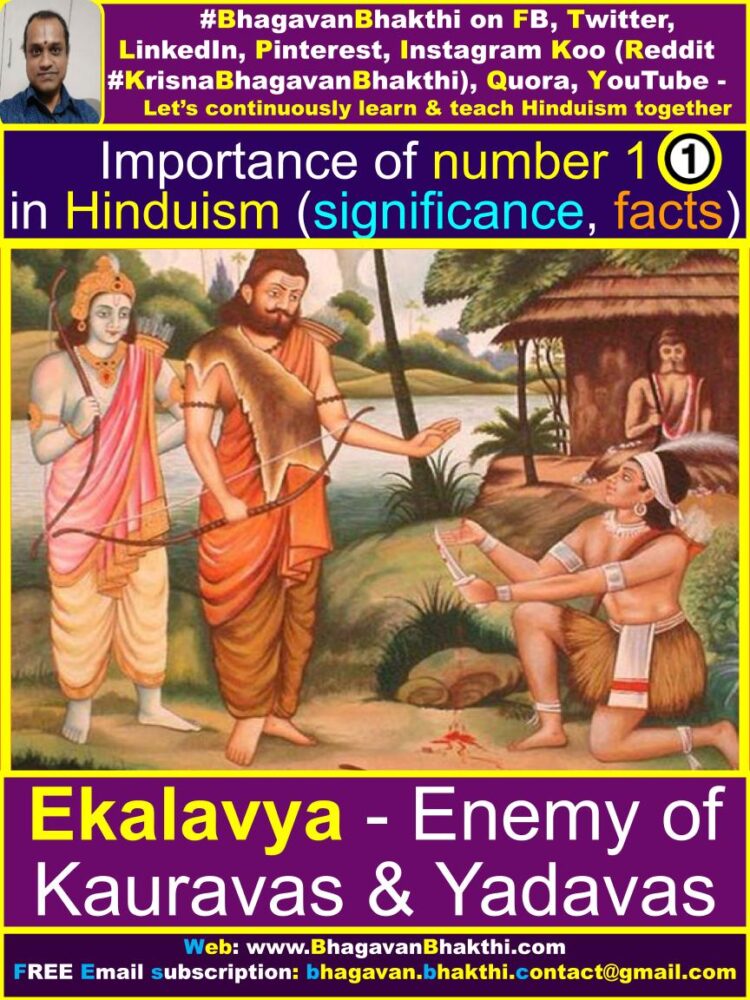
Ekasmai Namah (एकस्मै नमः) : In the great Sri Vishnu Sahasranama Stotram, that is, shloka #78, Lord Sri Vishnu is eulogized as follow:
एको नैकः सवः कः किं यत्तत्पदमनुत्तमम | लोकबंदुर लोकनाथो माधवो भक्त-वत्सलः ||
ಏಕೋ ನೈಕಃ ಸ್ಸವಃ ಕಃ ಕಿಂ ಯತ್ತತ್ಪದಮನುತ್ತಮಮ್ । ಲೋಕಬಂಧೂರ್ಲೋಕನಾಥೋ ಮಾಧವೋ ಭಕ್ತ-ವತ್ಸಲಃ ।।
ēkō naikaḥ s’savaḥ kaḥ kiṁ yattatpadamanuttamam । lōkabandhūrlōkanāthō mādhavō bhakta-vatsalaḥ।।
Lord Sri Vishnu is one and only one and no one is equal to himself and there is no one better than him. Lord Sri Vishnu cannot be grouped with others as belonging to a particular category. All who seek for Moksha, Madhava (Vishnu) is the one beyond which there is nothing else to be attained.
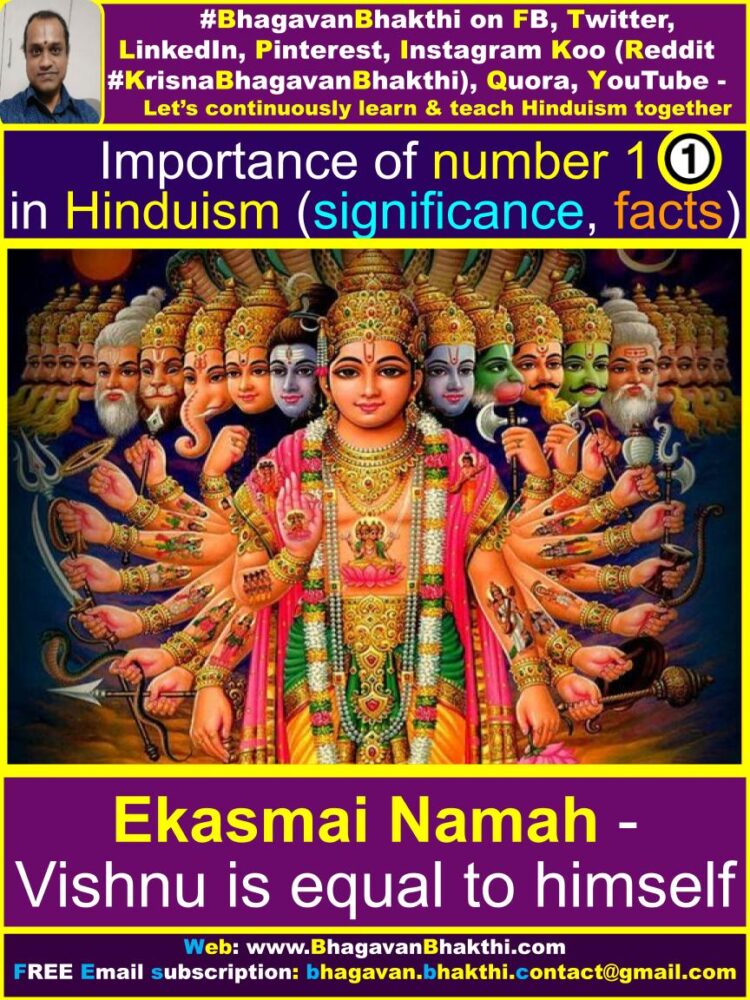
Ekodara (एकोदर) : Here Ekodara – Eko + udara – Eko = one, udara = womb.
The total meaning of this word is, two siblings (two males or two females or one male & one female) born from the same womb.
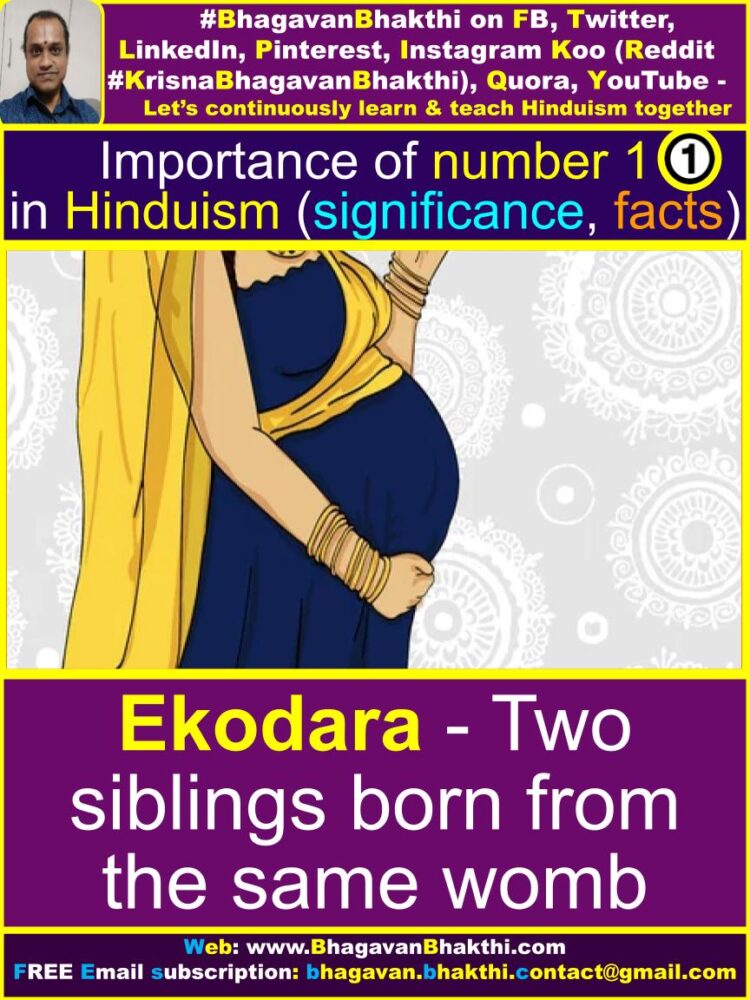
Eka Sloki Bhagavatam (एको श्लोकि भागवतं) :
आदौ देवकिदेवि गर्भजननं गोपीगृहे वर्धनम् | मायापूतन जीवितापहरणं गोवर्धनोद्धारणम् || कंसच्छेदन कौरवादि हननं कुंतीसुतां पालनम् | एतद्भागवतं पुराणकथितं श्रीकृष्ण लीलामृतम् || इति श्रीभागवतसूत्र ॥
ಆದೌ ದೇವಕಿದೇವಿ ಗರ್ಭಜನನಂ ಗೋಪೀಗೃಹೇ ವರ್ಧನಂ | ಮಾಯಾಪೂತನ ಜೀವಿತಾಪಹರಣಂ ಗೋವರ್ಧನೋದ್ಧಾರಣಮ್ || ಕಂಸಚ್ಛೇದನ ಕೌರವಾದಿ ಹನನಂ ಕುಂತೀಸುತಾಂ ಪಾಲನಂ | ಹ್ಯೇತದ್ಭಾಗವತಂ ಪುರಾಣಕಥಿತಂ ಶ್ರೀಕೃಷ್ಣ ಲೀಲಾಮೃತಮ್ || ಇತಿ ಶ್ರೀಭಗವತ ಸೂತ್ರ ।।
ādau dēvakidēvi garbhajananaṁ gōpīgr̥hē vardhanaṁ | māyāpūtana jīvitāpaharaṇaṁ gōvardhanōd’dhāraṇam || kansacchēdana kauravādi hananaṁ kuntīsutāṁ pālanaṁ | hyētadbhāgavataṁ purāṇakathitaṁ śrīkr̥ṣṇa līlāmr̥tam || iti śrībhagavata sūtra।।
Born to queen Sri Devaki Devi, brought up by Gopis, took away the life of Ogress Putana, Lifted the Govardhana mountain, Beheaded his uncle Kamsa, Helped in killing the Kauravas, And looked after the children of Kunti.
This is in short the ancient story of Srimad Bhagavatam, Which describes the nectar like play of Lord Sri Krishna.

Ekambareshvara (एकाम्बरेश्वर) : Ekaambareshvara – Eka + amba + Ishvara = one + mango + Bhagavan. Lord Sri Rudra Deva / Lord Shiva at the very famous and heritage temple of Kanchi is called as Ekaambareshvara.
The meaning is as follows: Lord Sri Rudra Deva / Lord Shiva is the Lord of Mango tree. It was the ancient Mango tree under which Goddess Sri Parvati Devi was doing tapasya / penance.
Lord Sri Rudra Deva / Lord Shiva is considered as an embodiment of Pancha Bhutas, that is, five prime basic elements of nature (Akasha / sky, Vayu / air, Prithvi / earth, Jala / water and Agni / fire). Lord Shiva’s Shiva Linga at Kanchi Kshetra is referred to as Prithvi Linga.
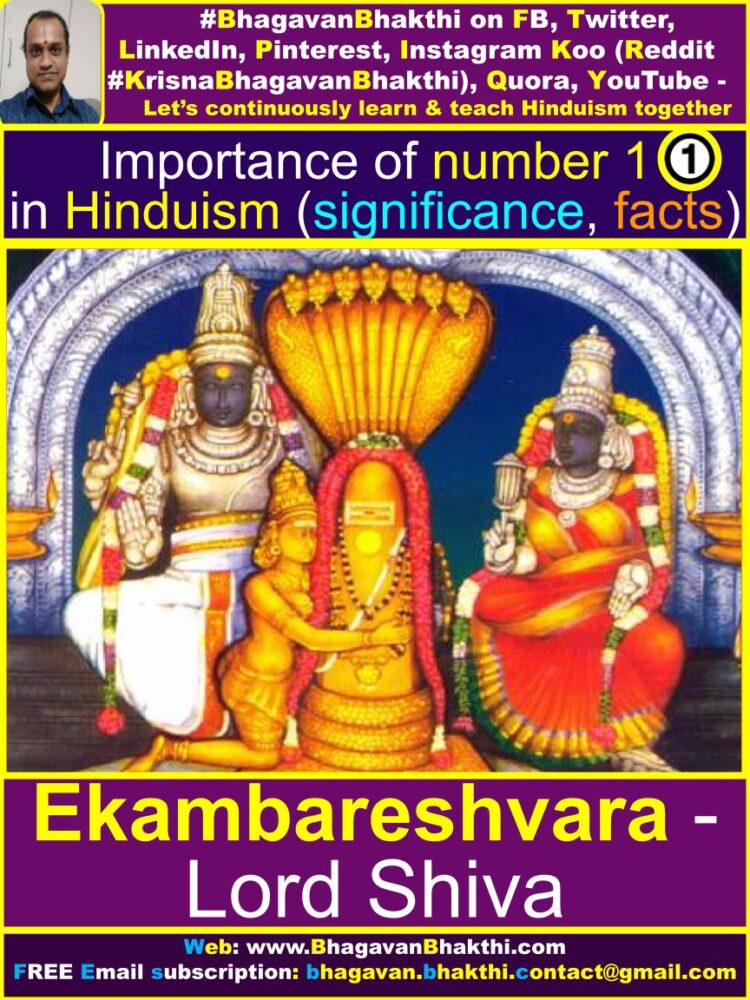
Ekanadi (एकनाडी) : In Hindu Sanatana Dharma jyotishya shastra / astrology is related to matching of charts for marriage. Here we can find a concept known as कूट / Koota agreement based on the birth stars of the two charts (bride and groom), where one of the factors of कूट / Koota agreement is Naadi.
It is assumed that नाडी कूट / Naadi Kuta has special reference to the health of the couple and implied to take cognizance of genetic compatibility. In jyotishya shastra / astrological terms नाडी / Naadi signifies the pulse.
And all the constellations (Nakshathras) are divided into three groups which in Ayurvedic terminology known as Vata (वात) (vāta), Pitta (पित्त) (pitta), and Kapha (कफ) (kapha) or Sleshma (श्लेष्म) (ślēṣma). These three groups or Naadis are ruled by different constellations.
While matching the charts, it should be ensured that Naadi of both the boy (groom) and the girl (bride) fall in different groups. If it is in the same group it is called as Ekanadi and such cases are not generally supported and approved in Hindu Sanatana Dharma.

Eka Chatradhipati (एक छात्राधिपति) : Eka Chatraadhipati – Eka + Chatradhipati (chatra + adhipati). Here, Eka = one, Chatra = under one umbrella, adhipati = ruler. This means someone like a Samrat (Emperor), unchallenged and sole ruler of the whole world.
Yudhishthira, Satya Harishchandra, Parikshit, Bharata (Bharat), etc. were called as Eka Chatradhipati in their times. In modern era King Shivaji was known as Chatradhipati.
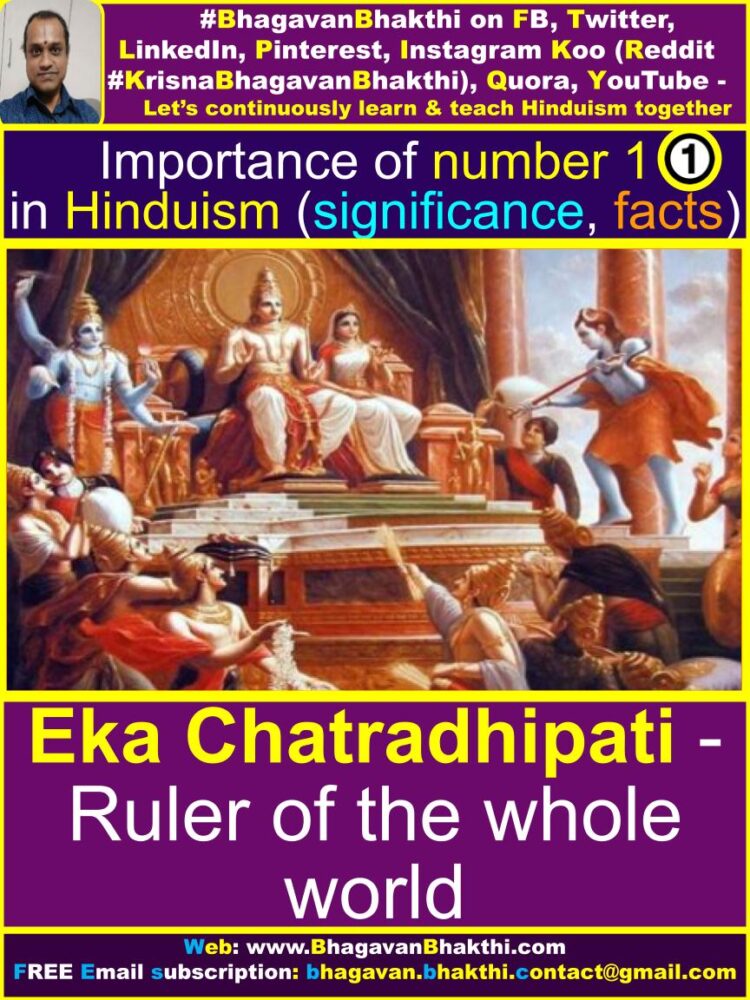
Ekakshara Mantra (एकाक्षर मंत्र) : Ekaakshara mantra = eka + akshara + mantra = one + akshara / alphabet + mantra.
Om (ॐ), that is, the ‘Pranava mantra’ is a single syllable mantra, that is, the Ekakshara mantra which is the ‘Parabrahma Svaroopam’, which is something unlimited, supreme, eternal etc.
We have several references in this regard. In Bhagavad Gita 8th Chapter, Shloka #13, it is referred to as ‘Aum Ityekaksharam Brahma’. In Rigveda ‘Sandyavandanam’ while invoking Goddess Gayatri, it is recited as ‘Aum Ityekaksharam Brahma’.
In Narayana Upanishad also we find such reference as ‘Aum Ityekaksharam’. ‘Om’ is the one Eternal Syllable of which all that exists is but the development. The past, present and the future are all included in this one sound, and all that exists beyond the forms of time is also implied in the word Om.
In Hindu spirituality, we find several ‘beeja mantras’ which are of ‘Ekaakshara’ (single syllable). Out of which, one of the most popular is that of ‘Sri Maha Ganapati’ (Gam).

Ekapade Namah (एकपादे नमः) : Ekapaade Namah = Eka + paade + Namah = one + led + Namah (Namaste). In the great ‘Sri Vishnu Sahasranama Stotram’ shloka #82 we can find the below:
चतुर्मूर्ति श्चतुर्बाहु श्चतुर्व्यूह श्चतुर्गतिः । चतुरात्मा चतुर्भाव चतुर्वॆद विदॆकपात् ॥ 82 ॥
ಚತುರ್ಮೂರ್ತಿ ಶ್ಚತುರ್ಬಾಹು ಶ್ಚತುರ್ವ್ಯೂಹ ಶ್ಚತುರ್ಗತಿಃ | ಚತುರಾತ್ಮಾ ಚತುರ್ಭಾವ ಶ್ಚತುರ್ವೇದವಿದೇಕಪಾತ್ || 82 ||
caturmūrti ścaturbāhu ścaturvyūha ścaturgatiḥ | caturātmā caturbhāva ścaturvēdavidēkapāt || 82 ||
Here, Ekapaad (Ekapade) indicates that the One with a single Paada (foot) or the one with a single leg or manifestation. In Lord Sri Vamana Avatar, Lord Sri Vishnu in his ‘Trivikrama’ form single footedly stood and measured covering the entire bhumandalam / Earth and the entire Aakasha (sky).

Ekakana (एक कण) : Here Ekakana – Eka + kana = one + cell. This means something which is having ‘Ekakana Jeevi’, that is, unicellular organism.
In Sanatana Dharma, we were very much aware of the ‘single cellular’ organisms also. That is the greatness of Hindu Dharma.

Ekatmane Namah (एकात्मने नमः) : Ekaatmane Namah – Eka + aatma + ne + Namah = one + soul + you + namah (namaste). This is given in Sri Vishnu Sahasranama Stotram shloka #103, that is:
प्रमाणं प्राणनिलयः प्राणभृत प्राणजीवनः | तत्त्वं तत्त्व विदेकात्मा जन्म मृत्यु जारातिगः ||
ಪ್ರಮಾಣಂ ಪ್ರಾಣನಿಲಯಃ ಪ್ರಾಣಭೃತ್ ಪ್ರಾಣಜೀವನಃ | ತತ್ತ್ವಂ ತತ್ತ್ವವಿದೇಕಾತ್ಮಾ ಜನ್ಮ ಮೃತ್ಯುಜಾರಾತಿಗಃ ||
pramāṇaṁ prāṇanilayaḥ prāṇabhr̥t prāṇajīvanaḥ | tattvaṁ tattvavidēkātmā janma mr̥tyujārātigaḥ ||
Lord Sri Vishnu is the solitary unique soul (Paramatma) of outstanding excellence. Lord Sri Vishnu is the ultimate spirit present in every being of the entire multiverses, heart and soul of the universe and the only ‘atma’ (soul) that existed in the beginning.
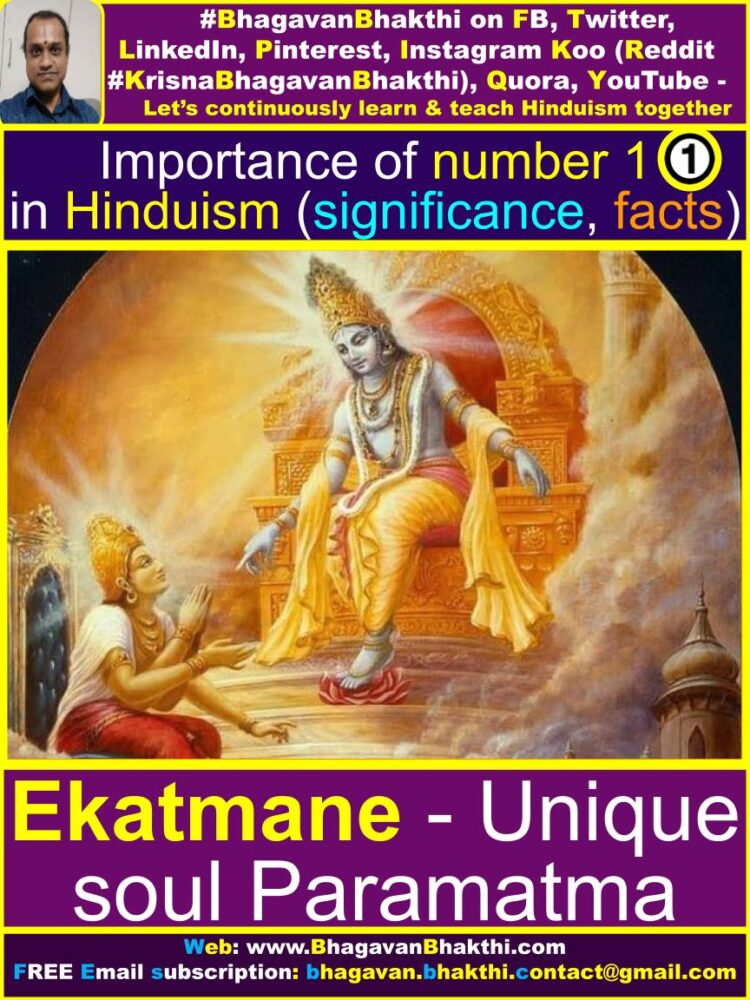
Eka Mukhi Rudraksha (एकमुखी रुद्राक्ष) : Eka Mukhi Rudraksha = Eka + mukhi + Rudra + aksha = one + faced + Rudra + divine tears.
Rudraksha in the botanical name is called as ‘Elaeocarplus Ganitras Roxb’ are the seeds of Rudraksha fruits from Rudraksha trees.
Traditionally we as Hindus are using Rudraksha since ages and they are said to have originated (manifested) from the tears that have fallen from eyes of Lord Sri Rudra Deva / Lord Shiva. They are used not only for religious or spiritual purposes, but they are also used on health grounds.
It is believed to have powerful electromagnetic properties in controlling stress levels, hypertension and induce tranquil feeling in the wearer. These properties are said to vary for different facets (mukhis).
There are several facets (mukhis) of Rudraksha, out of which one is said to be rare and very powerful is ‘Ekamukhi Rudraksha’, that is, the one with single facet (mukhi).

Ekadanta (एकदंत) : Ekadanta – Eka + danta = one + tooth. Ekadanta is a popular and one of the earliest names of Lord Ganesha. We usually see Lord Ganesha within his single tooth, that is, Ekadanta.
Lord Ganesha, in his second incarnation or avatar as Ekadanta, defeated demon named ‘Madaasura’ and his (demon) weakness was Mada (drunkenness, arrogance). This form of Lord Ganesha signifies readiness for sacrifice to complete any accepted task.
This we find when Lord Ganesh broke his own tusk to complete scripting of Mahabharata while dictated by Lord (Sage) Sri Vedavyasa Ji. Lord Ganesha is regarded as an embodiment of wisdom.
There is also another legend behind Ekadanta, according to which, Lord Ganesha’s tusk got broken while confronting with Lord Sri Parashurama.
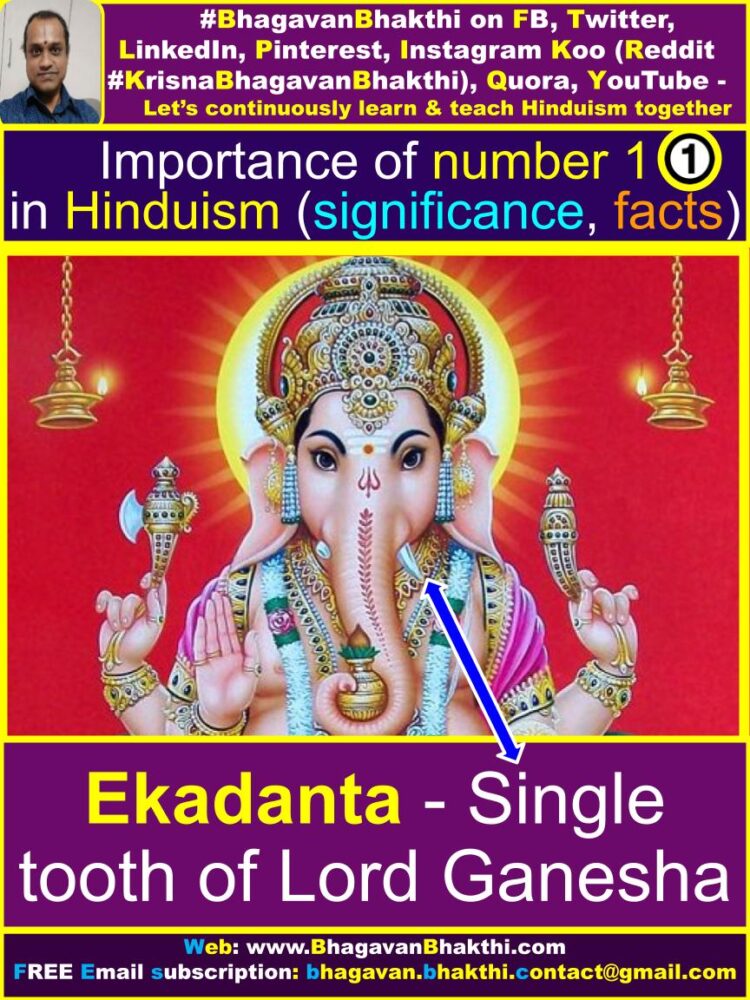
If you are aware of any such important fact about the number 1 (one) in Hinduism, kindly let me know.
More information will be added to this on regular basis. Please visit this post after some time to get updated information.
To watch videos on #Hinduism #Sanskrit language, SUBSCRIBE to my YouTube channel from this below link:
#BhagavanBhakthi YouTube channel
To know more about the “numbers importance, significance, facts in Hinduism“, visit the below link:
Numbers importance, significance, facts in Hinduism
Dear friends, if you need any clarifications about this post, kindly let me know, I will definitely try to answer all of them.
Also your one LIKE, one COMMENT, One Share, one SUBSCRIPTION is highly important.
This will help to know the quality of this content and also it will be helpful to know if any improvements is required for the content.
If you feel this content is useful to you and has helped you to improve your knowledge, kindly share this with your well-wishers.
Because “SHARING MEANS CARING”.
For receive FREE EMAIL SUBSCRIPTION about #BhagavanBhakthi, you can send an email to [email protected] from your email ID.
NAMASTE!
Sri Gurubhyo Namaha
Sri Krishnaaya Namaha
Sri Krishnaarpanamastu
Subscribe / Follow us Share in Social Media